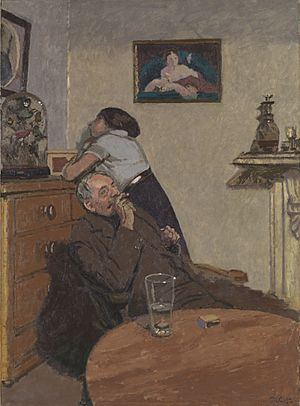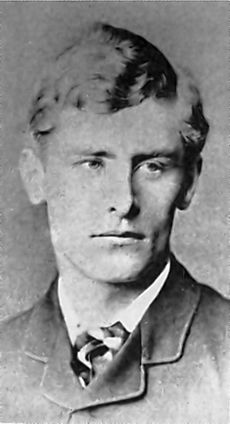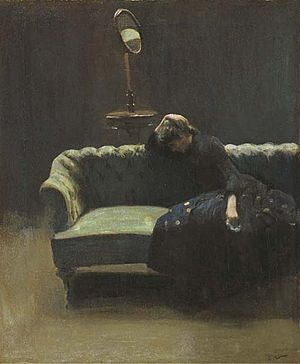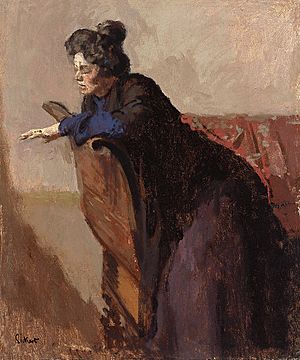Walter Sickert facts for kids
Quick facts for kids
Walter Sickert
RA RBA
|
|
|---|---|

Sickert photographed by George Charles Beresford, 1911
|
|
| Born | 31 May 1860 |
| Died | 22 January 1942 (aged 81) Bath, Somerset, England
|
| Resting place | Church of St Nicholas, Bathampton |
| Nationality | British |
| Alma mater | University College School King's College School |
| Known for | Painting |
|
Notable work
|
The Camden Town Murder Ennui |
| Movement | Post-Impressionism |
| Spouse(s) |
Ellen Cobden
(m. 1885; div. 1899)Christine Angus
(m. 1911; died 1920)Thérèse Lessore
(m. 1926) |
| Elected | Royal Academy Royal Society of British Artists |
Walter Richard Sickert (31 May 1860 – 22 January 1942) was a British painter and printmaker. He was born in Germany. Sickert was a key member of the Camden Town Group of Post-Impressionist artists. This group was active in London in the early 1900s.
Sickert had a big impact on British art styles. He was known for painting everyday people and city scenes. He also painted famous people and used newspaper photos for ideas. Many see him as an important artist who helped connect Impressionism to Modernism.
Contents
Becoming an Artist: Sickert's Early Life and Training
Sickert was born in Munich, Germany, on May 31, 1860. His father, Oswald Sickert, was a Danish artist. His family moved to England in 1868. They later became British citizens.
Young Walter went to University College School and then King's College School. He studied there until he was 18. Even though his father and grandfather were painters, Walter first wanted to be an actor. He acted in small plays before he started studying art in 1881.
Learning from Masters: Whistler and Degas
After less than a year at the Slade School, Sickert left. He became a student and assistant to James Abbott McNeill Whistler. Sickert's first paintings were small and focused on light and shade. He painted them quickly, just like Whistler.
In 1883, Sickert went to Paris and met Edgar Degas. Degas's way of using space and focusing on drawing greatly influenced Sickert. Sickert developed his own style of Impressionism. He often used darker colors. Following Degas's advice, Sickert painted in his studio. He worked from drawings and memory, not directly from nature.
In 1888, Sickert joined the New English Art Club. This group of artists was influenced by French realist art.
Painting London Life: Music Halls and City Scenes
Sickert's first important works were paintings of London music halls. These were popular entertainment venues. One of his paintings, Katie Lawrence at Gatti's, caused a stir in 1888. It showed a famous music hall singer.
He spent a lot of time in France in the late 1880s. He often visited Dieppe. Sickert also started writing about art for different magazines. Between 1894 and 1904, he visited Venice several times. He painted the city's buildings and scenes.

Sickert loved city culture. He set up studios in working-class areas of London. First in Cumberland Market in the 1890s, then in Camden Town in 1905. The Camden Town studio became very important for his art.
His famous painting, Ennui (around 1913), shows his interest in old stories. It depicts a couple in a dull room. They are looking into empty space, as if they can no longer talk to each other.
Founding the Camden Town Group
Just before First World War, Sickert supported new artists. These included Lucien Pissarro and Jacob Epstein. At the same time, Sickert helped start the Camden Town Group. This group of British painters was named after the London area where he lived. They officially formed in 1911. The group was influenced by Post-Impressionism and Expressionism. They focused on scenes of everyday suburban life. Sickert himself said he preferred painting kitchens over fancy living rooms.
From 1908 to 1912, and again from 1915 to 1918, he was an important teacher. He taught at Westminster School of Art. Many students learned from him there. He also started his own art school, Rowlandson House, in 1910.
Later Years and Changing Style
After his second wife passed away in 1920, Sickert moved back to Dieppe. He painted scenes of casinos and cafes. He returned to London in 1922. In 1924, he became an Associate of the Royal Academy.
In 1926, he had an illness, possibly a small stroke. In 1927, he started using his middle name, Richard, instead of Walter. His painting style also changed. Sickert stopped drawing as much. He began painting from snapshots, often taken by his third wife, Thérèse Lessore. He also used news photographs. He would enlarge the photos onto canvas. You could often see the pencil lines he used to do this.
Some people thought Sickert's later works showed a decline. However, these paintings were actually very modern. They were similar to the work of artists like Chuck Close and Gerhard Richter much later. Sickert also painted works he called "English Echoes." These were based on illustrations by Victorian artists. He would paint them in bright, poster-like colors.
Sickert painted a casual portrait of Winston Churchill around 1927. Churchill, who enjoyed painting as a hobby, learned from Sickert. He told his wife that Sickert was "giving me a new lease of life as a painter."
Sickert was President of the Royal Society of British Artists from 1928 to 1930. He became a Royal Academician in 1934. But he resigned in 1935 to protest a decision about sculptures. In his last years, his wife and assistants helped him paint more and more.
One of Sickert's closest friends was Lord Beaverbrook. He was a newspaper owner. Lord Beaverbrook collected the most Sickert paintings in the world. This collection is now in the Beaverbrook Art Gallery in Canada. Sickert also painted portraits of other notable people.
Sickert passed away in Bath, Somerset in 1942, at 81 years old. He is buried in the churchyard of the Church of St Nicholas, Bathampton. His sister was Helena Swanwick, a feminist and pacifist.
Sickert's Artistic Style and Subjects
At first, Sickert painted quickly with thin paint, like Whistler. Later, he used a more planned approach. He painted pictures in several steps. He believed in "cooking" his paintings, meaning he took his time. He preferred to paint from drawings or photos, not directly from nature. He would transfer his design to canvas using a grid. Then he would do a quick first layer of paint. After it dried, he added the final colors. He always wanted to paint quickly and simply.
Sickert often painted his subjects in a series. He is known for paintings of home interiors, Venice, music halls, and portraits. He rarely painted still lifes. In his music hall paintings, he often used complex angles. This made it hard to tell where the audience, performers, and orchestra were. Figures seemed to reach out to no one. Audience members stretched to see things beyond the stage. This idea of people not connecting often appeared in his art.
Sickert did not like thick paint. He once said that "thick oil-paint is the most undecorative matter in the world."
However, his Camden Town Murder series (around 1906–1909) used thick paint. These paintings influenced many British artists who came after him.
In the 1910s and 1920s, his dark colors became brighter. He started using unexpected colors boldly. His self-portraits often showed him playing a role, like an actor. His later works used thin layers of paint.
Sickert believed that art should tell a story. But he painted his subjects in a detached way. He often used snapshots and newspaper photos. He also copied other artists' work. His assistants helped him more and more with his paintings.
Walter Sickert and the Jack the Ripper Theories
Walter Sickert was very interested in the Jack the Ripper crimes. He thought he had stayed in a room once used by the famous serial killer. His landlady told him this. Sickert painted the room in 1905–1907 and called it Jack the Ripper's Bedroom. The painting shows a dark, sad room. It suggests his strong interest in the topic. However, there is good evidence that Sickert was not in the UK during most of the murders in 1888.
For over 80 years, no one thought Sickert was involved in the Ripper crimes. But in the 1970s, some authors started to suggest he might have been the killer or an helper.
In 1976, Stephen Knight wrote a book claiming Sickert was forced to help with the murders. This information came from a man who later said his story was not true. Later, in 1990, Jean Overton Fuller wrote a book claiming Sickert was the killer.
In 2002, crime writer Patricia Cornwell wrote a book stating Sickert was Jack the Ripper. She bought many of Sickert's paintings. Cornwell claimed that DNA from Ripper letters and Sickert's letters matched. However, many experts believe the Ripper letters are fake. Also, the Oxford Dictionary of National Biography called the idea that Sickert was Jack the Ripper a "fantasy." Many experts and biographers of Sickert have strongly disagreed with these claims.
Sickert's Papers and Exhibitions
Walter Sickert's personal papers are kept at the Islington Local History Centre. Other papers are at the Tate Gallery Archive. The Walker Art Gallery has the largest collection of his drawings.
Recent Exhibitions
In 2021–2022, the Walker Art Gallery in Liverpool held a large exhibition called Sickert: A Life in Art. It showed about 100 of his paintings and 200 drawings. It was the biggest show of his work in the UK in over 30 years.
From April to September 2022, Tate Britain also held a major exhibition. It was the first big Sickert show at the Tate in over 60 years. It featured more than 150 of his works.
See also
 In Spanish: Walter Richard Sickert para niños
In Spanish: Walter Richard Sickert para niños
- Elwin Hawthorne – artist, worked for a period as Sickert's assistant
- Florence Pash – artist, ran a private art school with Sickert in the mid-1890s







